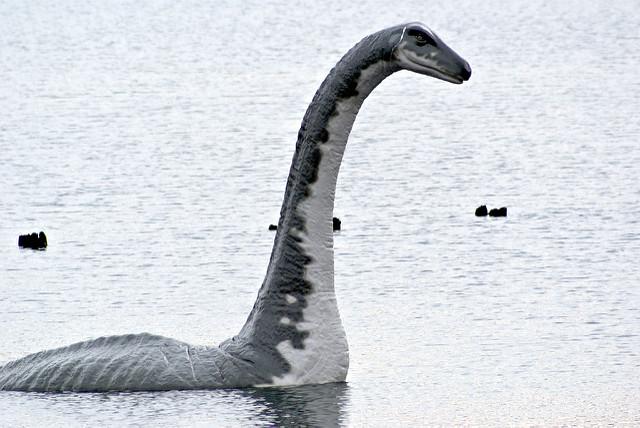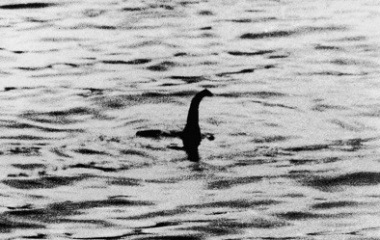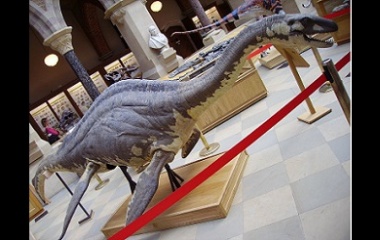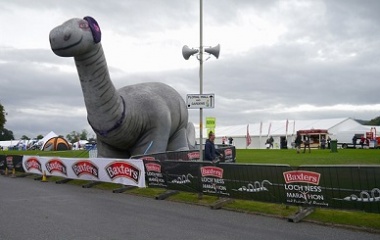What is the Loch Ness Monster?
Though there are many versions of the Loch Ness story, most tales will include some reference to a large dragon or dinosaur-like creature that can be spotted in the waters of the Loch Ness and sometimes in the surrounding land areas as well. However, most of these stories come to light after the 1930’s or were indirectly connected to the tale of Nessie by believers who wanted to add credibility to the Loch Ness story.

The story of the Loch Ness monster begins with water bailiff Alex Campbell on May 2nd, 1933. He identified the possibility of a monster in the loch while writing for the Inverness Courier as a part-time journalist. The original sighting of Nessie, however, was reported on August 4th in 1933 by George Spicer ad his wife. According to the report, George and his wife were driving on the road near the loch when he saw a creature that looked similar to a dragon and which he assumed had to have at least a few prehistoric ties. In the report, he states that this creature was simply waddling across the road with an animal in its mouth.
After George’s report was filed with the ‘Courier’, the news publication began receiving more and more anonymous letters claiming to have either seen the monster themselves or to know a person that had seen the monster. Some of the letters even contained family legends that had supposedly been passed down and mentioned a similar monster at least once. The media, of course, had a field day deciding on an appropriate name for the creature. They started by calling the mysterious creature a ‘monster fish’ before progressing to ‘sea serpent’, ‘dragon’, and finally ‘Loch Ness Monster.’
The Loch Ness Monster Changes Scotland
The news of the new cryptid spread quickly and raised many questions – namely where had it come from and where there any other accounts of the creature in history that had been overlooked? There was also a need for proof that drove tourists and cryptid hunters alike to the Loch Ness in search of a chance to be the first to provide concrete evidence of its existence.
Many changes were made with the introduction of the Loch Ness Monster. Inverness suddenly became a place of intrigue and wonder with many new possibilities for the community presenting themselves seemingly overnight. This proved to be even more true when the first photograph of the monster (taken by Hugh Gray) was published on December 6th, 1933.
Concrete evidence of the monster prompted the country to act quickly. The Secretary of State for Scotland ordered the police to prevent anyone from attacking or harming the creature. This only added to the growing curiosity of the public – after all, if the country of Scotland was willing to write legislation to protect the creature it must exist, right?
Investigations into the history of the creature were launched. It was hypothesized that a creature so large wouldn’t have been able to escape history unnoticed – perhaps there was proof of the Loch Ness Monster in the past that had somehow been overlooked. Although there never was definitive proof of Nessie’s existence, there was enough curiosity to put the country on the map, causing many to wonder if the whole thing hadn’t just been a hoax.
History of Ol’ Nessie
When historical investigations in to the possibility of the beast began, it was found that the earliest reference to Nessie may date back to the sixth century AD. This clue was found in the text, ‘Life of St. Columba’, which was written by Adomnán. According to the writer, the monk may have encountered a similar monster.
St. Columba Wards Off a River Monster
The Irish Monk, St. Columba, was traveling with his followers when the happened to pass by the River Ness and see locals burying a man. He questioned them as to what had happened and they explained that the man had been swimming in the river when a ‘water beast’ attacked him and drug him underneath the surface. His friends nearby rushed out in a boat to try to save him, but by the time they reached him in the water he was dead.
At this point, St. Columba had a devout follower swim across the river in an attempt to lure out the monster. Half way through, the beast attempted to attack the follower but St. Columba made a sign of the cross and spoke the following words:
“Go no farther. Do not touch the man. Go back at once.”
Those who were watching claimed that the creature drew back as if it were being pulled by chains or ropes and retreated. Everyone there took the event as a sign from God and the townspeople thanked St. Columba for his great service to them.
There are some who claim that the link between St. Columba and the Loch Ness monster is weak at best. Additionally, they point out that another Scottish monster – the Kelpie – is a more likely candidate for the inspiration of the story.
D. Mackenzie Sights the Monster in 1871
In October of 1871, D. Mackenzie claimed that he had seen an object in the Loch Ness that he first assumed was a log or an upturned boat. However, as he continued to watch this mysterious object, it disappeared into the water with alarming speed that could have only been a living creature.
Many believers like to point to this report as proof that the monster does, indeed, exist. The problem with this narrative, however, is that Mackenzie didn’t file the report until 1934 – after interest in the beast had already been made prevalent. Because of this, many disregard the story as an attempt to become famous.
George Spicer’s Sighting of Nessie in 1933
It is alleged that George Spicer and his wife came face to face with the Loch Ness Monster while driving on the newly upgraded road that went by the lake on July 22nd, 1933. Their report of the creature was published in a newspaper on August 4th of the same year. They described the beast as being at least 4 feet high and 25 feet long. It had a large, wavy neck, that was at least as long as the road itself (10 to 12 feet). They couldn’t make out any limbs, but watched it lumber across the road to the loch, leaving crushed undergrowth in its wake.

Many have hypothesized that the Loch Ness Monster hadn’t been spotted earlier because the road wasn’t often used by locals or tourists. However, due to recent upgrades, it was only a matter of time before the public would have encountered the water monster. It is also important to note that these speculations have been called wishful thinking by many – the road had been used frequently for the construction of the Caledonian Canal, making it just as unlikely that the monster had always frequented the area.
Hugh Gray’s Photo in 1933
Hugh Gray’s supposed photograph of the Loch Ness Monster in 1933 was essential in helping to make Nessie one of the most popular cryptids in modern day. He claimed to have taken it on November 12th, 1933. There were issues with the image from the start – it was a bit blurry and many people noted that it almost looked like the head of a dog if one was to look closely. This went a long way in discrediting the image because it was known that he had been walking his dog when he had taken the picture.

In 1963, however, the original negatives were recovered. They proved that the photograph was not simply a blurred image of Gray’s dog. Unfortunately, they were also proven to be something other than the Loch Ness Monster. The original photo was an otter rolling at the surface of the loch as otters often do.
Arthur Grant Hits the Loch Ness Monster
In one of the more curious sightings, Arthur Grant claimed to have literally ran into the Loch Ness Monster on his motorcycle on January 5th, 1934. He was riding his motorcycle at about 1:00 a.m. on a moonlit night. Grant claimed to have seen the neck of the beast and when asked to sketch and describe the creature said it was something like a cross between a seal and a plesiosaur. He was so intrigued with the creature that he got off his bike to follow it into the water, but was not quick enough and only saw the ripples that were left behind.
Although Grant was certain that he had encountered the Loch Ness Monster, local zoologists determined that he had likely only seen an otter or seal. The large size difference in the beast he described and what they proposed as actuality was accounted for by claiming that the poor lighting conditions caused him to mistake the creature as being much larger than it actually was.
The Infamous ‘Surgeon’s Photograph’ in 1934
Perhaps the most famous of all the Loch Ness Monster photographs was taken in 1934 by Robert Kenneth Wilson and published by the Daily Mail on April 21st, 1934. Wilson didn’t want to have his name associated with the photo, which led to the image being associated with his profession instead. It quickly caught on as ‘Surgeon’s Photograph.’ However, his unwillingness to be associated with the image also led to much speculation that was later proven to be true.
At first, the image seemed to be legitimate. The cropped version, which was printed in the paper, made the ‘monster’ seem enormous and the ripples in the water appear to be large waves. However, when the uncropped image was studied years later, there were details that didn’t seem to add up. Eventually the picture was determined to be a hoax – a scheme cooked up by Christian Spurling and his friends as revenge against the Daily Mail – who happened to be his employer. Spurling had reported to find ‘Nessie footprints’ that were later determined to be fakes. He and his friends crafted a toy model that could be used to simulate Nessie, then took pictures and had a friend sell them to the Daily Mail.
The Lost Taylor Film
On May 29th, 1938 a tourist by the name of G. E. Taylor took a film of what he believed to be the Loch Ness Monster. The film was in color and had three minutes of recorded footage on 16 mm film. The film was sold to Maurice Burton (a popular science writer) but was not shared with other researchers. The film was largely forgotten until 1961 when Burton published a single frame from the footage in his book. Burton claims that the film was of a floating object – not an animal. However, since the original footage has never been released to the public, its unlikely that we’ll ever know for sure.
Promising Sonar Readings
In December of 1954, the crew of the Rival III took sonar readings that found a large object was keeping pace with their boat from a depth of nearly 500 feet. It was detected for 800 meters before contact with the object was lost. Though this was never proven to be the Loch Ness Monster, it is one of the most valuable pieces of evidence to at that point in history that had come to light.
The Disndale Film – The Fake That Turned Into a Promising Lead
In 1960, Tim Disndale filmed a hump in the Loch Ness that left a large wake behind it. Disndale was an aeronautical engineer who had reportedly taken the footage on his last day of searching for Nessie. He said the object appeared to be reddish in color with a blotch on its side and produced 40 feet of film that he claimed could prove the existence of the Loch Ness Monster. However, when the image was enhanced, it could be seen that the hump was a boat.
The film was largely dismissed until 1993 when Discovery Communications decided to make a documentary on the Loch Ness Monster. While enhancing the Disndale film to use as part of their production, someone noticed a strange shadow in the negative that couldn’t be clearly seen in the film. When the team enhanced and overlayed images to study the shadow, they discovered what appeared to be the back half of a creature under the water.
Apple Adds to the Conspiracy in 2014…
On April 19th, 2014, it was discovered that there was a large creature just below the surface of the Loch Ness on Apple Maps. The image of the creature was discovered at the north end of the loch and suggested that the creature was close to 98 feet in length. Although no tampering was found with the Apple Maps image, there are alternate explanations that skeptics have proposed instead of accepting the image as proof. The top explanations claim the image is caused by the wake of a boat that was lost in image stitching, ripples created by seals, or floating wood that just so happened to look like a 98 foot creature.
…Which Led to Google Looking to Get in On the Monster Hunt in 2015
On the 81st anniversary of the ‘Surgeon’s Photograph’, Google celebrated with a Nessie-themed doodle and a new feature on Google Street View. This new feature allowed users to search for Nessie both above and below the waters of the Loch Ness. Google reportedly spent a week gathering images for this feature in order to gain popularity with Nessie’s fans and cryptid hunters alike.
The Hunt Begins
With so much misleading and unreliable evidence, cryptid hunters and fans of Nessie took to the loch in several attempts to prove the existence of the creature once and for all. Although there has never been enough evidence from any of the expeditions to prove the existence of Nessie, the search parties have continued well into modern day.
The Edward Mountain Expedition in 1934
In 1934, Edward Mountain financed a search for the now famous Loch Ness Monster. The search party consisted of 20 men who positioned themselves around Loch Ness for 5 weeks from 9:00 am to 6:00 pm. All 20 men were given binoculars and cameras to search for evidence of the monster. At the end of the search, 21 photos had been taken. Unfortunately, none of them were considered clear enough to be used as evidence of Nessie’s existence.
The supervisor of the group, James Fraser, claimed to have captured video footage of the monster on September 15th, 1934. Zoologists claimed the film contained images of a seal. Unfortunately, this footage has since been ‘lost.’
The Loch Ness Phenomena Investigation Bureau
The failures of the Mountain party didn’t discourage other groups from conducting their own searches. In 1962, the Loch Ness Phenomena Investigation Bureau (LNPIB) was formed by Norman Collins, R. S. R. Fitter, David James, Peter Scott, and Constance Whyte. The group tracked the Loch Ness legends for 10 years before disbanding in 1972.
D. Gordon Tucker Conducts Sonar Studies 1967-1968
In 1967, D. Gordon Tucker volunteered his services as a sonar developer as part of a larger movement that was being conducted by the LNPIB. He fixed a large sonar transducer underwater in the hopes of finding proof of the Loch Ness Monster. During a two week trial, several targets were identified. At least one has been discredited as a large shoal of fish, but others moved at speeds of up to 10 knots and did not appear to be fish or any other known aquatic lifeform in the area.
Operation Deepscan in 1987
In 1987, 24 boats were equipped with echo sounder equipment and used as part of ‘Operation Deepscan’ – a mission to find Nessie. The results found a large mass at the bottom of the loch. Many wrote off the reading as being a pile of debris, but motion in three of the images made this questionable. There are skeptics who claim that this motion was likely caused by seals entering the loch, but others point to the Loch Ness Monster.
The Origins of Nessie
With so many contradicting claims, it is doubtful if we will ever truly know what is actually to cause for the sightings in Inverness – the human imagination, or Nessie herself. However, there are several theories for what could be causing the strange appearances along the Loch Ness.
Eels
Because they are known to inhabit the Loch Ness, it makes sense that a giant eel could have been the cause of all the Loch Ness Monster sightings. Many propose that it could have been this creature that was responsible for leaving wakes in the water and confusing tourists.
However, there are many who doubt this theory. Eels are known to move from side to side, similar to the manner in which snakes move. This contradicts many of the reports that claim that the Loch Ness Monster was spotted moving up and down out of the water.
Still, the distance at which many of the sightings occurred do make it plausible for the Nessie sightings to have been confused with a large eel. Plus, sightings of other ‘sea serpents’ in Scotland have been proven to simply be large eels, lending further credibility to this theory.
The Greenland Shark
In 2013, Jeremy Wade of the ‘River Monsters’ TV Show theorized that the Loch Ness Monster may simply be a Greenland Shark that found its way into fresh water. This species of shark is known to be found in the North Atlantic Ocean, making it probable that it could have found its way into Scotland.
It is known to be dark in color and can grow to up to 20 feet in length, making it a viable candidate for the Loch Ness sightings. However, it has yet to be reported that this species of shark was actually found in the Loch Ness, making this notion no more than a wishful theory to date.
The Existence of A Different Monster
There are some who theorize that the Loch Ness Monster could just be a name for another one of Scotland’s monsters – the Kelpie. This water horse monster has a similar M.O. to Nessie, making some wonder if the Loch Ness Monster could have developed based on the telling of older legends. Studies of Kelpie lore indicates that the Loch Ness is one of the most common lochs mentioned in the horror tales. Though this is an intriguing theory, there is no proof to back it.
A Plesiosaur in Modern Day
There were also those who realized that the Loch Ness Monster descriptions matched that of the plesiosaur almost perfectly. This created excitement over the speculation that a dinosaur species may have survived into modern day. Many arguments were made against this however, due to the cold temperatures of Loch Ness and the lack of food supply needed to support the beast.











If water horses existed this could be one , loch Ness is a sea loch , like loch long , to which I have been , sometimes hump back Wales are seen in loch long , the monster could be mistaken for one such mammal , as the Atlantic and north sea surround Scotland , I live within sight of The North Sea which is connected to loch Ness . My sister and her husband have sailed on loch Ness and saw nothing . People have said they have seen things indescribable in the loch . We might never know the answer in my lifetime .